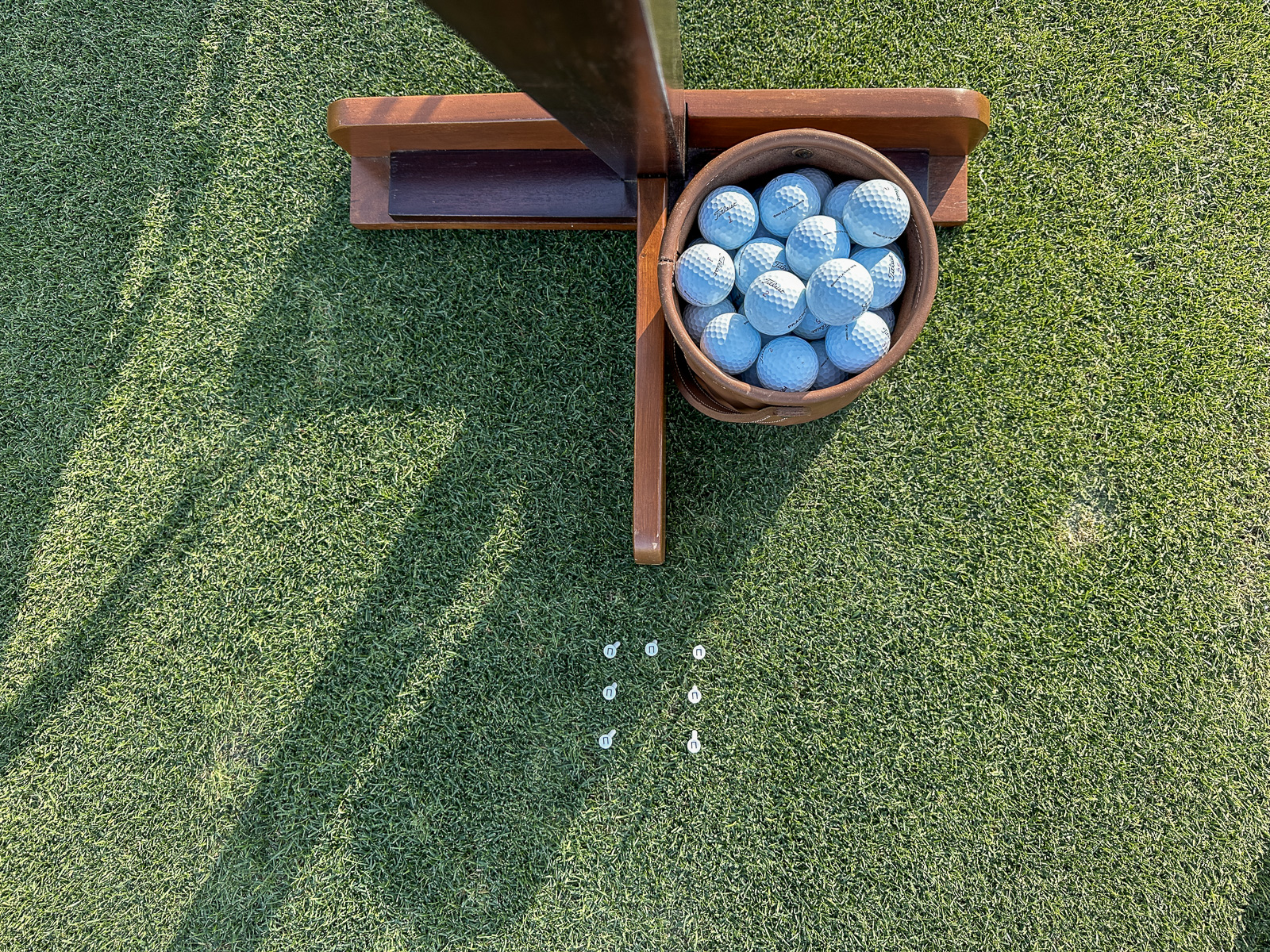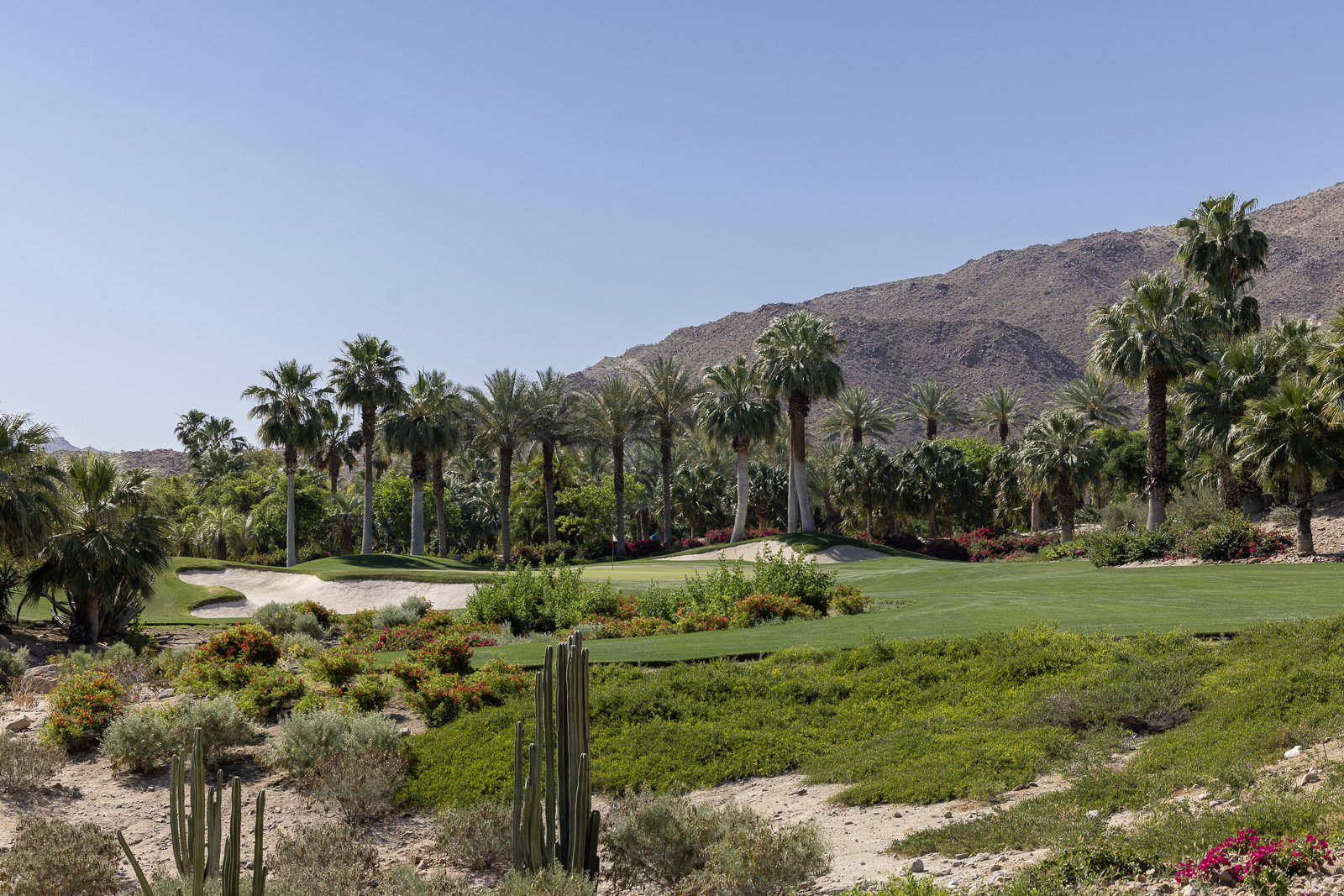Over the last decade if you were to look at any list of the toughest tee times in golf, undoubtedly, Porcupine Creek would be among those listed.
The course is set across a private estate in a hidden enclave of Ranch Mirage, California – about 25 minutes from the Palm Springs airport.
I’m not sure there’s another course in America that has held as much mystique as Porcupine Creek.
The only way to even get a glimpse of it if you’re not on property is to hike up a the difficult “Bump and Grind” hiking trail through the mountains above the property.
For years the course was the stuff of legend, and was a place I’d always wanted to see.
But considering the only people generally invited were “Presidents, foreign dignitaries, celebrities, and other private guests of one of the richest men in the world,” I’d resigned myself to the fact an Augusta invite was more likely.
But now? All of that has changed.
It’s still arguably the most exclusive “public course” in the world, but it’s accessible.
And I just got to play it.
Not only did they exceed my expectations, the entire Sensei Porcupine Creek experience blew them out of the water.
Today I’m going to tell you all about the course, the history of the property, how you can play it, and what makes it one of the most unique golf experiences the world has to offer.
If you want to hear more about the resort, spa, and dining, you can read my full recap of the retreat.
In a decade of writing about golf courses on Breaking Eighty, this is one of the posts I’ve been most excited for. So let’s dig in.
The History of Sensei Porcupine Creek
Located on 230 acres outside of Palm Springs, Sensei Porcupine Creek was built in 2004 by billionaire Tim Blixseth and his wife Edra.
Along with the massive estate house and guest villas on the property, the Blixseths built the Porcupine Creek golf course as their own private course.
No one knows for sure who did the full design, but Tom Weiskopf, Dave Stockton, and Annika Sorenstam have all been noted as potentially having a hand in it.
In 2011, the family sold the estate to Oracle Founder Larry Ellison.
For another decade Mr. Ellison improved the estate, made updates to the golf course, and kept access unbelievably limited. As I mentioned above, unless you were a celebrity or dignitary you probably weren’t playing the course.
To put this in perspective, I know people who have played just about every golf course in the world. I don’t know anyone personally who has played, and the people I’ve heard about that have seen the course are other media members who’ve been there over the past year.
Introducing Sensei Porcupine Creek
A few years ago, Mr. Ellison and Dr. David Agus had a mutual friend who passed away.
They got to talking about how they could make a real difference in helping people live longer and healthier lives.
This materialized as Sensei.
The first Sensei property is on the Hawaiian island of Lana’i.
The second is Sensei Porcupine Creek.
The wellness retreat opened in November 2022 and features 21 rooms, casitas, and villas.
Everything about the property revolves around its 3 tenets: Move, Nourish, and Rest.
Golf aside, the experience at Sensei was above and beyond anything I expected.
I’ve done another very in-depth review of the rest f the resort which you can find here.
Today, we’re talking specifically about the golf course and experience.
Embracing the “Peace of Play” Mindset
Despite now technically being a public course, Sensei Porcupine Creek gets extremely little play.
Everything I’d heard was that no matter when you visit the retreat and golf, you’d feel like you had the course all to yourself.
I didn’t fully believe it.
That is until I showed up this past week, and my wife and I were the only ones golfing.
All day.
Just us.
We had the full course to ourselves to do whatever we wanted.
They call this “Peace of Play”.

No matter what, they limit the golf to a small number of rounds a day. The idea is for every guest to feel like they truly have their own private golf course for the day.
And as such? Pretty much just about anything goes.
Want to play barefoot? Cool.
Blast music? Awesome.
Go play a hole again just because you loved it? Do it.
I even played a little cross-country golf, making my own par 3 from the 10th tee box down to the 13th green.
The entire experience is surreal, special, and wildly enjoyable all at the same time.
First Impressions of the Porcupine Creek Golf Course
One of the great things about Sensei Porcupine Creek is its size. It’s big enough that you can spread out and will rarely see other guests, but small enough that it’s easy to get anywhere on the property quickly.
The property is the single most well-landscaped place I’ve ever been.
Ever.
There are dozens of different species of plants and trees throughout the property and golf course.
While I have yet to play Shadow Creek, that’s the first thing that came to my mind upon seeing the course.
In most cases, you can’t see any other holes during your round, as you’re surrounded by flora and fauna everywhere.
The fact it was built and maintained in this way, despite living most of it’s life as a truly private golf course is pretty remarkable.
There’s no “clubhouse” so to speak, but the Golf Pavillion is about a 2-minute walk from the main Estate.
Walking inside it feels like a luxurious living room.
In part because, well, it was.
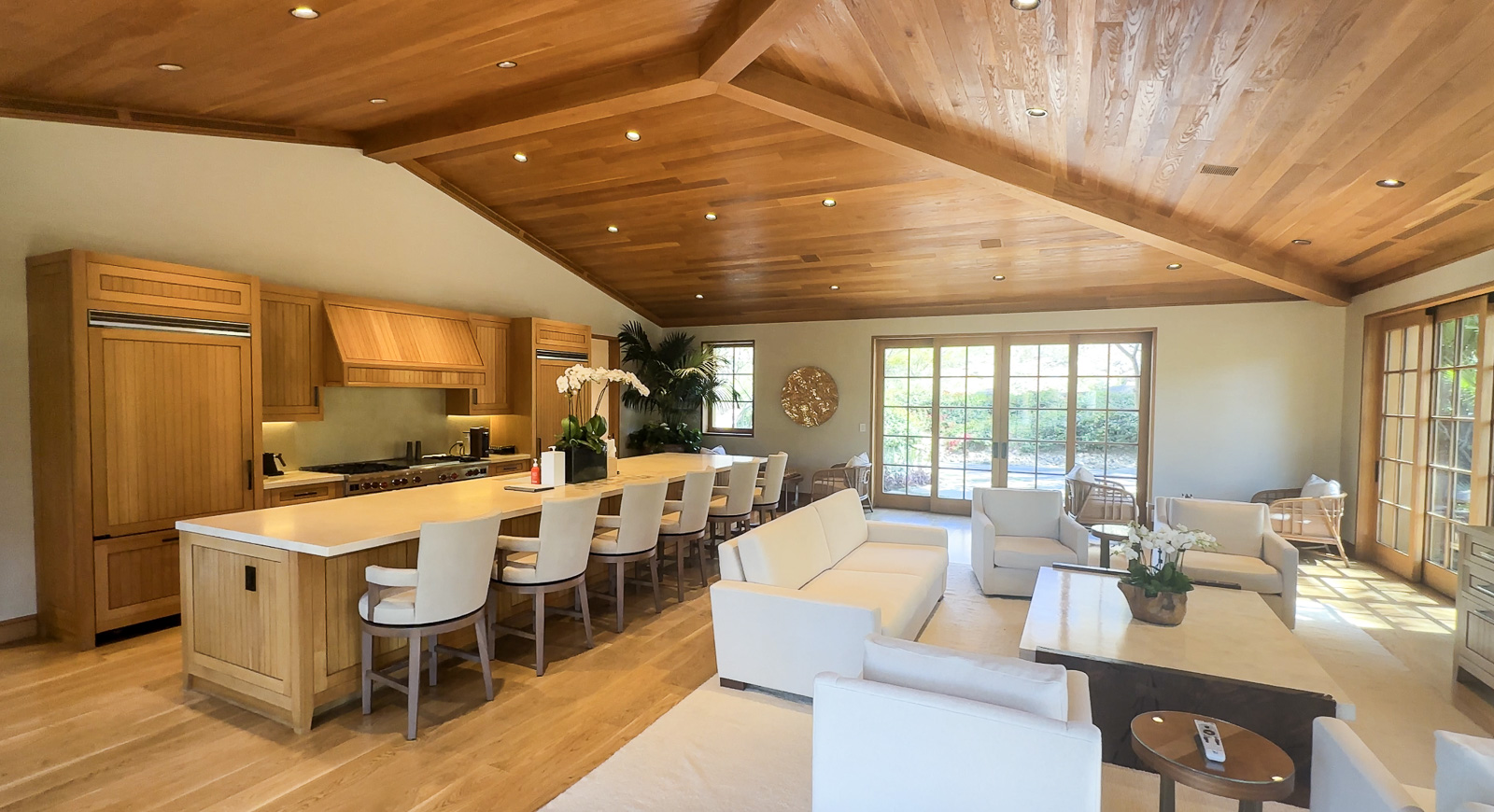
Both the golf and tennis pavilions (defacto clubhouses), feel like you’re being invited into someone’s home.
The golf pavilion is stunning with a massive island and chef’s range in the back, and a beautiful living room with golf on the TV.
You’ll also find a peaceful sitting area with a chess board, should you feel so inclined.
The driving range is one of the most impressive I’ve seen. At first glance, it’s easy to mistake it for a par 3 course.

There were only 4 spots set up on the range, and our bags were waiting for us when we arrived.
I’ve very rarely seen a golf course that was in as immaculate condition as Sensei Porcupine Creek.
There wasn’t a single ball on the range, and taking a divot out of the grass felt sacrilegious.
The leather bags held Pro V1s (of course) and the tees were made into the shape of the Sensei logo, one of dozens of tiny details that make a difference throughout the property.
Between the range and clubhouse is a practice green, and behind the range there’s shaded seating area as well.
One fact I heard is that most PGA-caliber courses have 32-36 blades of grass per square inch. Sensei Porcupine Creek has 46 on average. I can’t confirm this, but it feels right. The fairways were as lush as anything I’ve seen.
The only thing that was even a little bit out of place during our stay was some of the green surrounds were a little thin, as they’ve been experimenting with a new form of drought-resistant grass. But this didn’t affect our play or experience a single time during the round.
Included with your tee time is a Sensei leather ball pouch that has 2 sleeves of Pro V1 balls, tees and ball markers, chapstick, and a yardage book.
It’s a very nice extra touch, and for the price you’re paying to be there – is perhaps even expected. We’ll talk about cost and how to play the course at the end of this post.
The Front 9 of Sensei Porcupine Creek
Everything I’ve read is that the golf course is set across 75 acres of the 230-acre property. 75 acres for a golf course is incredibly small.
But I question that number. The course feels like it encompasses a large part of the property, and never once feels cramped or like it’s lacking for space.
I’ll be honest, I expected Sensei Porcupine Creek to be ok as a golf course. I figured the enjoyment in playing would be more around the experience and exclusive nature of it.
I was wrong.
This is a golf course.
There are strategic decisions to make on every hole, and some wonderful architectural elements.
The greens have more undulation and interest than I was expecting.
Despite only stretching out to around 6700 yards from the tips, there’s plenty to keep golfers engaged whether you’re a scratch or just starting.
I don’t normally do full hole-by-hole recaps of golf courses these days, but in this case, I feel like an exception needs to be made.
Hole 1: (Par 5, 513 Yards)

You have a strategic choice to make from the very first shot you hit on the course.
A bunker crosses the fairway. Bailing out left is the safest play, but it will make getting home in 2 more difficult due to the deep bunkers guarding the front of the green.
Take it over the right-hand side of the bunker, you’ll find a little less fairway, but a much better angle on your second shot into the green
1 is a great risk/reward par 5 that gives you a chance to make a good score early.
Hole 2 (Par 3, 154 Yards)

It was on the 154-yard par 3 second that I had my first “how is this real life?” moment.
The entire hole is framed by beautiful palm trees and bougainvillea plants.
It’d be the signature hole on most courses. Yet here I was with my wife, and it was all ours.
With no one else on the course all day, we could play it over and over if we wanted.
That sense of privacy and “peace of play” never gets old.
You can also call or text at any time to have food or drinks delivered directly to you out on the course.
We enjoyed some fresh fruit and a “breakfast burrito” off the 2nd green.
I put breakfast burrito in quotes because all the food at the resort is done by Nobu.
Yes, that Nobu.
If you’ve never had a breakfast burrito made out of puff pastry and Karobuta sausage before? You should add that to your to-do list.
Hole 3 (Par 5, 516 Yards)

The 3rd hole is another reachable par 5 that gives you a chance to score. I love how friendly the opening holes are. It gives you a chance to ease into the round, but with some nice green contouring and deep bunkering – they certainly aren’t pushovers.
There’s a centerline fairway bunker that you really have to be mindful of on your approach. I decided to lay back behind it on my 2nd, giving me a 9 iron into the green.
3 is one of only a few holes at Sensei Porcupine Creek that feels tight off the tee. But the reality is, it’s not as bad as you might think.
I found throughout the course, often when I had shots I missed (usually a slice), when I got up to my ball I found it surprisingly still in play.
They do a good job of opening up some of the places where golfers are most likely to miss, making for a more friendly round for newer golfers.
This was one of the first times ever my wife joined me for a full 18 holes. And as a non-golfer, I can’t imagine a better setting to bring someone who is intimidated by golf.
Aside from not wanting to disturb the immaculate turf, having so much privacy allowed her to actually feel comfortable playing golf.
Hole 4 (Par 4, 383 Yards)
As you make your way to the 4th tee box, you’ll notice one of the most unique features of the golf course: the sculptures.
Sensei Porcupine Creek has a world-class collection of sculptures.
And when I say world-class, I mean it. Every single sculpture throughout the grounds (of which there are many) would be right at home at any of the most notable museums in the world.
As you proceed to the 4th hole, it’s impossible not to notice the towering and colorful Keith Haring sculpture, Acrobats.

Considering you can generally play as slow as you’d like, it gives you a chance to actually go and appreciate the uniqueness of the experience and art.
The 4th is a pretty straightforward par 4, and another one of the tighter feeling holes on the course.
Hole 5 (Par 3, 190 Yards)
A strategic par 3 with bunkers long right and short left of the green. Watch out for a sucker pin position on the far left-hand side of the green.
Hole 6 (Par 4. 359 Yards)

This is one of my favorites on the front 9.
At 359 yards, it’s a short-ish par 4 with a dogleg left. There’s a bunker sticking straight out on the right side of the fairway, so a well-struck straight shot will likely find it.
This forces you to either turn the ball over to get a nice roll up towards the green or lay back and use less than driver.
Hole 7 (Par 4, 296 Yards)

6 will bring you back near the clubhouse, where you can stop at the obligatory comfort station to stock up on your choice of complimentary refreshments.
7 is another great par 4 that gives you all kinds of options.
At only 276 yards it’s technically drivable, but with a shallow green, and a small pond fronting the entire left-hand side of the green, getting your shot to hold will be a challenge.
There are some pretty stunning water features throughout the course and the property as a whole, leading to an oasis-like vibe. The creek meandering down the left of the fairway is a great example of this.
Hole 8 (Par 4, 394 Yards)
The 8th is a straightaway par 4. It represents a challenging stretch as its the #3 handicap hole on the course, followed by 9 which is #1.
Should you do as I did and find yourself with an errant slice, don’t feel too bad. Amidst the villas situated off the right of the fairway, you’ll find two more Keith Haring statue. These will have you forgetting about your bad shot, while you’re reminded once again, that you’re currently being treated to one of the great golf experiences of the world.
Hole 9 (Par 4, 416 Yards)

The 9th is a 416 yard par 4, that just requires two solid golf shots. Stay out of the right fairway bunker and be thoughtful with your approach to a green that’s well-defended by 3 bunkers.
Once again 9 brings you back to the clubhouse where you can stock up on refreshments, have lunch, or do whatever else you want before heading out to the rest of your round.
The Back Nine at Sensei Porcupine Creek
I was told that the back 9 had better views than the front. But considering how beautiful the front 9 was and how much I enjoyed it, I thought “how much better could it be?”
It didn’t take long to find out.
Hole 10 (Par 4, 420 Yards)

As you meander your way up the cart path to the 10th tee box, you get your first glimpse of real elevation change.
After proceeding up the staircase to the 10th tee box you’re treated to one of the best views on the course.
The 10th also happens to be one of the best holes on the property as well.
The tee shot on the 420-yard hole to the fairway way down below is easily one of the most fun (and strategic) shots on the course.
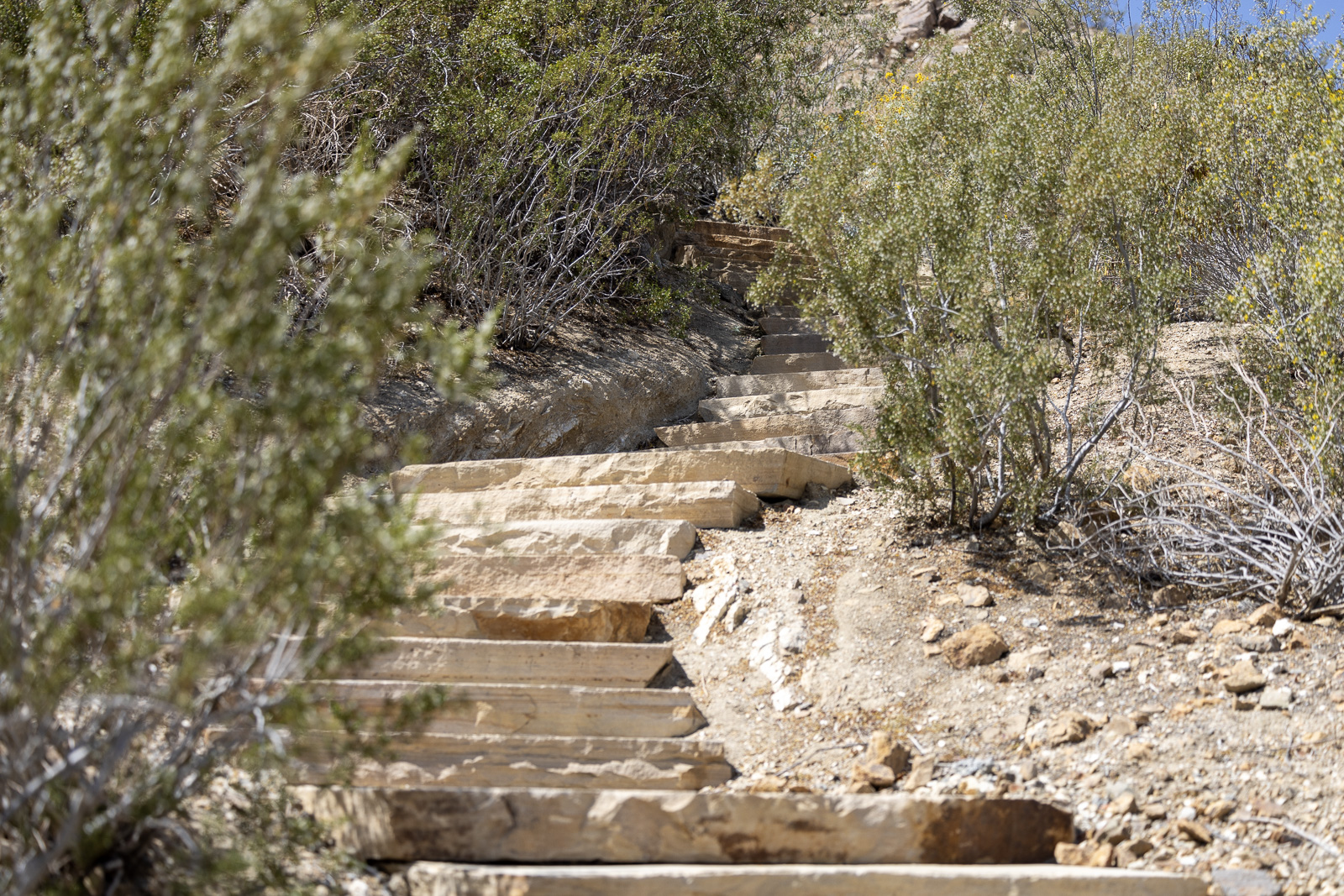
There’s a large bunker in the center of the fairway that’s very much in play. If you’re feeling confident, going to the more narrow sretch of fairway to the right of it will give you the best angle into the green.
The safe play is staying left, which is more open, but will force you to carry a deep greenside bunker for all but a far-right pin position.
I loved the front 9. But as I’m going back through the round to write about it, I’m realizing just how special the back 9 is here.
Hole 11 (Par 4, 280 Yards)

The 11th is unique in that it’s one of the only holes that takes you straight up into the mountains. It’s an uphill drivable par 4, that plays only 280 from the tips – or 250 from the Silver tees where I played.
It’s a really well-designed hole.
You’ll see a bunker about 3/4s of the way up the dogleg right fairway. Your line is crucial here. For me, if I play my fade off that bunker, there’s another slightly hidden bunker on the right that I just barely missed.

You can play smart with an iron to the left and still only have a wedge into the hole.
The green is one of the smallest on the course. Despite that, it’s still one of your best birdie chances out there.
Hole 12 (Par 3, 190 Yards)

12 comes back out of the mountain towards the rest of the property and is a stunning par 3.
The green has a ton of undulation, so being thoughtful about where the pin is and where you aim is crucial here.
The landscaping is also in peak form on this hole, as I think it’s one of the most beautiful on the property.
Hole 13 (Par 5, 559 Yards)

13 is the longest hole on the course, measuring 559 yards from the back tees.
If you can clear the left-hand bunker off the tee, you’ll find plenty of room on the split fairway with the 10th hole.
This will also give you a better angle for your second shot and allow you to decide if you want to layup or try and go for it.
Despite significant bunkering down the right side, once you get up towards the green there’s quite a bit of room to bailout above the green should you have the length to try and get home in 2.

For me? I just tried to get it down past the island separating 10 and 13 to give myself some space and a short approach.
Hole 14 (Par 4, 313 Yards)

14 has my favorite green complex on the course.
It’s a short 313 yards, and driver directly over the mountain ridge on the left is going to give you a wedge in – and hopefully take the large fairway bunkers out of play.
14 features a kidney-shaped green with 3 bunkers guarding it in front. Pay close attention to where the pin is and dial in your distances, as there isn’t much room for error here.
Hole 15 (Par 4, 217 Yards)
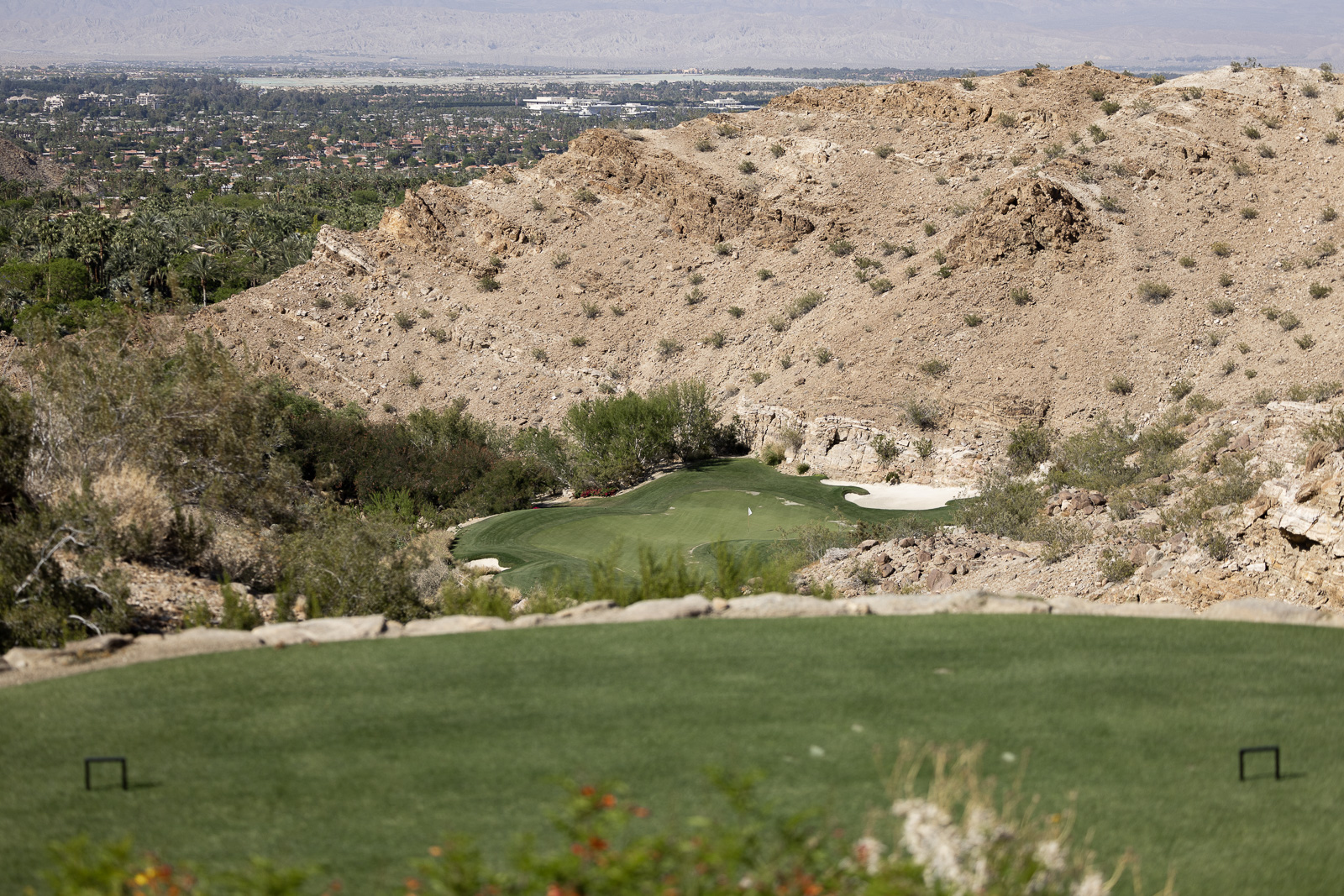
If there’s one hole at Sensei Porcupine Creek you may have heard of, this is it.
After the 2-minute drive past the lake and up into the mountains you’ll reach the highest spot on the course.
The views of the Coachella Valley and property are insane, but it’s the green complex way down the canyon that you should be paying attention to.
The 200+ yard shot is one of the most fun shots you’ll ever have in golf.
Watching the ball tower up into the sky before hopefully landing softly on the green will never get old.
It’s a large green that gives you a little bit of margin for error, but it’s still daunting nonetheless.
You should also be sure to go hit a ball from the forward tees which is a much shorter and more forgiving shot, but is just as fun.
Hole 16 (Par 4, 475 Yards)

I don’t know how many “signature holes” a course is allowed to have, but this is another one.
The tee box is high up over the course, and you hit over a lake down to the fairway with a large bunker in the center staring you in the face.
You see this general design on a few different holes on the course (1 and 10 come to mind), where choosing one side of the bunker is a more challenging shot, but gives you a better approach angle.
That’s what you get here on 16 too.

Go left and you have a bit more fairway, but a less than ideal angle into the green, that’s potentially longer as well.
The pond and waterfall around this green only add to the experience.
Hole 17 (Par 4, 484 Yards)

The par 4 17th is a long par 4 with a wide fairway allowing you to hit a confident driver.
Just try not to be distracted by the beautiful stream and landscaping along the right-hand side.
Hole 18 (Par 5, 506 Yards)

The back tee boxes on 18 are among my favorites on the course. You’ll hit directly over a pond, and need avoid well-placed bunkers in the landing area.
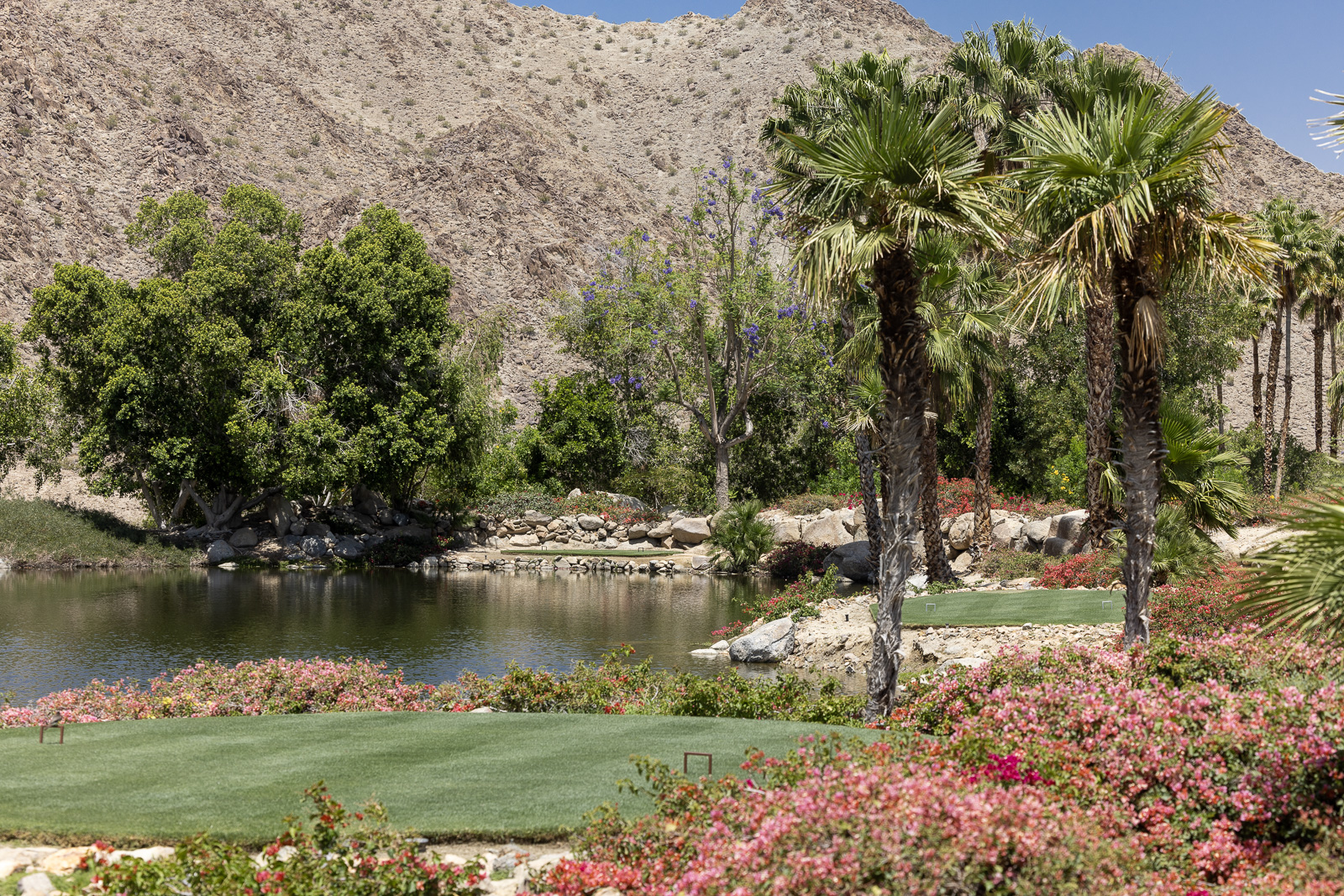
Despite only being a 506-yard par 5, it’s the #2 handicap hole – and an excellent finisher.
Hole 19: The “Bye Hole”

I didn’t know Sensei Porcupine Creek featured a “Bye” hole until I was walking off 18 and said “wait, what’s that green over there?”
It makes sense. If I had my own private estate with a golf course, i’d want a debt-settling hole as well.
And this one’s a stunner.
It’s short at less than 100 yards, but with a beautiful creek with multiple waterfalls along the front of it, make sure you have enough club to avoid getting wet.
How to Play Sensei Porcupine Creek and Final Thoughts

Words simply can’t describe how special the experience of golfing here is.
As someone who’s only a 10 handicap, trending towards 15, I appreciated the length. I played from the Silver tees at around 6200 yards – which for me was a really fun distance.
It gave me chances to score well, get home in 2 on some par 5s, and even have a shot at driving the green (or close to it) on a couple of par 4s.
Golfing with my wife made it even more memorable, and it’s the first time we’ve played where I really felt like she was enjoying the round as much as I was.
There’s so much more I could say about Sensei Porcupine Creek, and I will, in my review of the Retreat itself.
But suffice it to say, this is a golfing experience I’ll remember for the rest of my life.
I don’t think it’s a stretch to say it’s the most exclusive “public” course in the country. As the experience I enjoyed there felt more private than even the most private clubs I’ve played.
Obviously, an experience like this doesn’t come cheap.
In the peak season rooms generally start at $1,650/night. Currently, for the off-season, there are some dates where you can stay for “just” $1,000/night.
Golf is only available to hotel guests and it’s $950 in the peak season, or $650 in the off-season, which is May 1st -July 15th, when it closes for the season.
A lot of money to be sure.
But in terms of the whole experience, I put this up against any “top 100” or resort experience I’ve ever had.
It’s that good.


